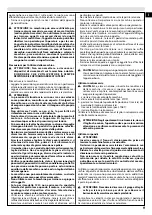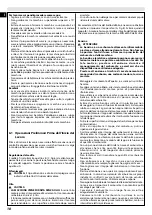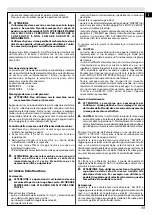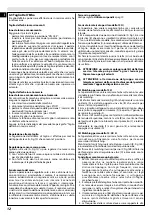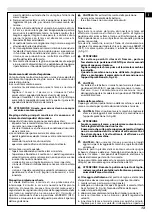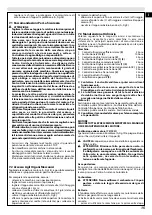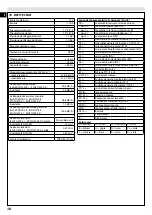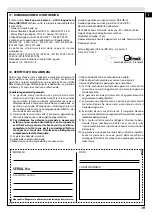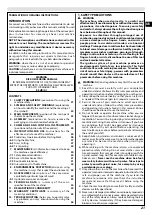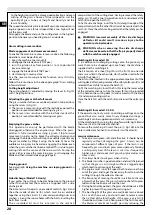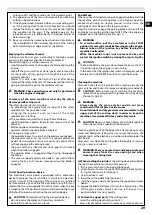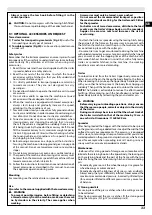
GB
23
Battery charger
WARNING: Check that the battery charger provides a
constant voltage and is compatible with the battery.
Do not use fast battery chargers.
WARNING: Pay careful attention to the warning
symbols indicated on the battery charger.
The battery charger must only be used with 12 V batteries and
connected to an efficient and safe power socket matching the
voltage and frequency values indicated on the battery charger
data plate.
The battery charger is supplied with crocodile clips for
connecting to the battery. When connecting the clips observe
the correct polarity:
Red cable = Positive terminal (+)
Black cable = Negative terminal (-)
WARNING: If the battery is not removed from the
machine on which it is mounted, make sure that the
key is in the OFF position.
First connect the battery charger to the power socket and
then connect the crocodile clips to the battery terminals.
To disconnect the battery charger, first disconnect the black
clip (negative terminal) (-) to prevent accidental short-circuits.
Do not leave the battery charger disconnected from the mains
while connected to the battery; this may discharge the battery.
WARNING: Reversing polarity may damage the battery
charger or the battery. The use of non-original
accessories and connection cables may cause polarity
reversal, even if the colours of the cables are the same.
While charging and for at least an hour after charging, the
battery releases explosive and toxic fumes.
WARNING: Charge the battery in a well-ventilated
place. DO NOT SMOKE AND KEEP AWAY FROM OPEN
FLAMES AND SPARKS.
Connecting the battery (Fig.3)
Remove the cover (C) by pulling it as shown in the figure.
First connect the red cable (A) to the positive terminal (+) and
then the black wire (B) to the negative terminal (–), using the
bolts, nuts and washers supplied as shown in the figure. Refit
the cover correctly, first inserting it into the two slots (D) and
then the two slots (F).
Charge the battery according to the following indications:
Constant voltage range: 14.40 - 14.70 V,
Max initial current: 2.0 - 4.0 A,
Charge time: 12 - 24 h.
Wait at least 4 hours after charging before using the battery.
The battery must be recharged as soon as possible after it
becomes fully discharged.
Battery charger in critical conditions
In the event that the battery is subject to deep-discharge or has
been left discharged for extended periods (>15 days), it is advisable
to charge the battery at a constant current of 0.5-1.0 A for at least
10-12 h, then proceed with normal charging as specified above.
WARNING – DANGER OF SHORT-CIRCUIT:
Never directly connect the positive and negative terminals
of the battery with a cable or other metal object. Do not
place tools on top of the battery. Use tools (a screwdriver
or pliers) with insulated handles only.
CAUTION:
If the battery is not sufficiently charged, the
machine’s circuit board will not activate.
WARNING
- Do not try to disassemble, repair or tamper with the
battery or battery charger.
- The electrolyte is a substance that is hazardous to human
health. If electrolyte comes into contact with skin and/or
clothes, wash immediately with copious amounts of
water. If electrolyte comes into contact with the eyes,
wash with copious amounts of water and seek medical
attention.
- Store the battery out of reach of children.
- Do not store the battery in closed containers. If keeping
in enclosed rooms, make sure that there is sufficient
ventilation. Leaking gas may cause explosions, fires,
damage to property and bodily injury.
Disposal
The battery and battery charger must never be disposed of
with normal household waste, instead hand them in to your
dealer or a specialist recycling centre.
Fitting the steering wheel (Fig.5)
Put the machine on a flat surface and straighten up the front
wheels. Insert the steering wheel (A) into the projecting shaft
(B), making sure that the spokes (3) are facing toward the seat.
Align the hole on the steering wheel hub with the hole on the
shaft and insert the pin supplied (C). Drive the pin through
using a hammer, making sure that it projects fully from the
opposite side.
CAUTION: To avoid damaging the steering wheel with
the hammer, it is advisable to use an awl or a
screwdriver of suitable diameter to push the last part
of the pin through.
Fitting the seat (Fig.6)
Remove one of the two snap rings (A, Fig.6) and slide out the
pin (B). Then fix the seat (C) with the pin (B) and reassemble the
snap ring (A). Connect the power cable connector (E), making
sure to insert it in the spring (F).
CAUTION: If the connector (E) is not connected, the
machine will not start.
Fitting the grass-catcher (Fig.7)
First assemble the frame, attaching the upper section (A) to the
lower section (B) and to the reinforcement (C), using the 2 bolts
(D), 2 nuts (E) and 4 washers (F) supplied, following the
sequence indicated.
Position the 2 crossbars (G) and fit them to the frame using the
4 pins (H), securing them with the 4 cotter pins (L).
Insert the frame into the grill with back plate (M), ensuring that it
is correctly positioned along the base perimeter. Hook all the
plastic profiles to the frame tubes with the help of a screwdriver.
Model 13H only: Fit the 2 handles (N) to the cover (P), using
the 2 bolts (Q), 4 nuts (E) and 4 washers (F) following the
sequence indicated.
Complete the assembly of the cover with the 2 front bolts (R),
the 2 rear bolts (R) and the 4 nuts (T).
Lastly, position the knob (V) on the grass discharge tube (Z)
and insert the tube in its housing, securing it with the pin (H)
and cotter pin (L).
Summary of Contents for Rider 72
Page 5: ...S1 S3 Q1 H1 Q0 B Q0 3 S6 X115 2 S2 S4 Q0 Q1 Q1 1 S3 S7 S1 S4 S2 S6 25 ...
Page 6: ......
Page 8: ......
Page 201: ......

